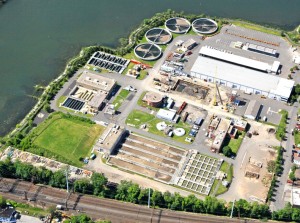Norwalk keeps head above water
In light of recent beach closures and flooding, Norwalk is looking like a tall, clear glass of water.
The city invested millions of dollars in the early 1980s on its water management infrastructure and today reaps the benefits. It recently won the Silver Peak Performance Award presented by the Nation Association of Clean Water Agencies “for its outstanding compliance in the 2012 calendar year.”
Only 400 of the nation”™s 14,000 treatment plants were so cited.
“Our mission is to protect the environment and do it in a sustainable way,” said Lisa Burns, managing director of the Norwalk Water Pollution Control Authority (WPCA). “We try to do the right thing.”
In Stamford, beaches close any time there is more than an inch of rain, as runoff into the Sound can include human or animal fecal matter. But in Norwalk, which recently spent $40 million on additional water quality controls, there hasn”™t been a beach closure in three years where the WPCA was responsible.
“We”™ve been working on improving the systems so we don”™t have combined sewer overflows anymore,” Burns said. “We”™ve invested in infrastructure and have a supportive board of directors that have undertaken small rate increases to ensure we have a good capital program.”
By investing early and installing gradual rate increases, Norwalk has avoided the problems its neighbors now face, Burns said. Norwalk holds one of the least expensive rates in the region, too.
Meanwhile, Stamford just transitioned into an unpopular rate increase to maintain its treatment facility. And businesses and politicians alike in Bridgeport have blamed the city”™s dated combined sewer system for massive inland flooding during Hurricane Sandy.
Acting Bridgeport WPCA General Manager William Robinson congratulated Norwalk on its latest award, but he noted Bridgeport, which is a much larger and older city, faces bigger challenges than Norwalk.
Since 1990, Bridgeport has worked to separate its sewer system, which collects and treats rainwater in the same systems as household waste. But it”™s an expensive task to undertake.
Currently, Bridgeport is in the process of a $395 million project to limit its combined sewer overflows into the Long Island Sound. But its problems won”™t end there when the project is complete. Any time there is a major storm, Robinson said, there”™s “nothing the collection systems can do” to prevent flooding.
In contrast, Burns said, flooding in Norwalk during Hurricane Sandy was limited. The WPCA didn”™t receive any Norwalk-related flooding complaints.
As soon as the region started experiencing major storms in 2006, Burns said the agency began diligently putting together plans to address storm water management. It has hired consultants, made long-term plans and purchased new equipment to address flooding. The agency owns five wastewater vacuum trucks and two TV camera trucks to inspect possibly clogged pipes. Burns said she doubts other cities in the region have the same capacity.
“We try to maximize all our resources and try to be the most efficient with everything we do,” Burns said. “The flooding would have been much worse if we wouldn”™t have planned ahead.”
